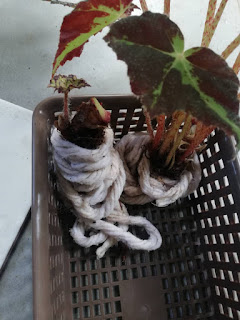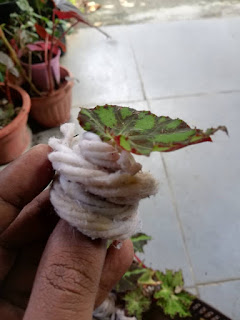How to Grow and Cultivate Begonia:
How to Propagate Begonia:
Best Method - Step by Step (in pictures)
After many many countless trial and error.
In fact more killing and less survival of these begonias.
When I'm almost gave up on them, I found the most unconventional way of growing them.The idea is far mind boggling and I must admit that
I tried few times and failed miserably.
Finally I got this time right and I'm sharing
this exclusive secret of how to grow these begonias.
All credit goes to Bmb Albert from Singapore.
Without his advise and directive, it would had been another failed attempt and me given up on begonias.
So here it is, Introducing:
Begonias in Wick Medium
Begonia Fireworks doing so well in the wick medium
where it doesn't become floppy or burned rather well maintained and stable in set-up.Here, I'm going to show you how I had set it up
Step by Step:
First get the materials - you will need:
1) Mop Wick.
(remove other matters, just use the mop wick only)I had tried trimmed thin cloth material:
It appeared fine for few weeks but the cloth started to dis-integrate and harbor fungus.
The begonia too rotted.
So, I would rather caution you not to try with cloth material unless you want to experiment with something that can handle with water in long term.
a) Soak the mop wick overnight and wash, rinse and repeat 2 -3 days if possible.
Let the wick fully soak in a bucket of water
as the wick tend to expand more fully when it fully soaked.
Remove the soaked water, squish off the remain water and wash again for few times.
Wash few times to remove whatever chemical & bleaching residue on the yarn or cotton fibers.
You will notice a white dye clouded in the soaked water.
Dispose the water and repeat few times until the soaked water is appears without any dye stain or chemicals.
2) A Basket.
you can use any sturdy plastic container as long as it drains out easily and not hold water.
Do not use any organic woven basket that might rot over time.
3) A Water Container.
you can put in aquatic plants or fish to deter mosquito breeding from the water container.
Do get these things ready in few days ahead before setting or removing the begonias from the soil medium.
4) Carefully Remove the Soil Medium from the Root-ball.
It will take a lot of work and patience
- so do take consideration of the time needed to set this up.
After few dips and you noticed that the root-ball is clear from fine peat material,
its ready for the next step.
There might be some fine little pieces of coco-peat or soil / medium material lodged in between the tight root ball. It's fine to leave them as your intention is to remove as much as possible.
5) Roll the Mop Wick around the Root Ball.
Roll the mop wick carefully around the root ball and carefully place the begonia inside the basket with some of the strands extending out into the water container.
6) Arrange the Composition.
Arrange accordingly based on your preferred colors and height of the begonias.
Carefully lay rolled mop wick around the begonia root-ball
so that its almost tight and stable as it would sit comfortably inside the basket with few stands extending into the water container.
(not too tight and not to loose as it might fall off)
7) Roll the Broken Foliage Pieces Together.
You can also use a singular leaf for new propagation
but the new growth may take few weeks and it open for possibilities that the leaf may or may not survive. 50-50 chances.
But it is better than throwing them away and the chances of new plant-let appearing is greater than the ones rooted in water or other mediums.
8) Check the Water Level in the Container.
Do check that the wick drops into the water container long enough that it touches
for the water to be constantly in flow with the begonia root ball. Once I had taken for granted and the wick was dangling
without touching the water and the plant was dehydrated.
This is how it looks like.
Do make sure that you drop few wicks into the water if you have a lot of begonias drinking from a small holder.
9) Check the Firmness in the Begonia Leaves.
Check the firmness of the leaves:
If it is firm and strong - then the begonia is actually doing fine.
If it is floppy then the begonia is thirsty - drop a few more strands into the water.
10) Do not Disturb the Root-ball in the Mop Wick.
Another note is that it is not advisable to remove the mop wick after the roots had stabilize. The roots tend to interconnect with the wick and hence it creates a network of roots all over.
Removing them from the wick and planting them back into a soil medium will throw the begonia into a shock, making them dormant or worse - the plant suffers and dies.
Finally,
Do place these set-up in a bright shaded area.
They can handle water poured or sprayed on them and also some dose of sunlight upon the foliage depending on the type of begonia.
You can also use foliage fertilizer sprayed weekly on the leaves and they will do just great.
Once the plant had stabilized, it will grow majestically.
THE ADVANTAGES OF USING MOP WICK AS MEDIUM:
1) The medium will always remain moist because of the mop wick.
2) The mop wick surface will always remain cool at around 23°C
3) The begonia roots love the air movements in the mop wick because of the air-gaps in-between the mop materials.
4) The begonia roots will consistently be receiving nutrition from the mop materials due to the wick absorption which replaces any loss moisture that had being dehydrated by wind etc.
5) Due to the condition of the medium used instead of soil, You don't have to be worried about watering them and this free you from the daily watering hassles.
You only need to watch the water reservoir and to refill water when the water level drops.
6) Your begonia will not be over or under water with this wick material system.
7) The surrounding area will be having good humidity which begonias love to grow in it.
8) Those begonias which were grown in wick material will able to withstand the hot weather especially during a hot dry day for a longer time without getting its leaf burned.
6) Your begonia will not be over or under water with this wick material system.
7) The surrounding area will be having good humidity which begonias love to grow in it.
8) Those begonias which were grown in wick material will able to withstand the hot weather especially during a hot dry day for a longer time without getting its leaf burned.
Just to list out the advantages that you will notice when you set the begonias in this method.
Do share with me when you need more information or your experience in this set-up.
UPDATES ON BEGONIA CULTIVATION & GROWTH
The Material required:
1) Mopwick- washed, soaked and rinsed for few days to a week - water changed daily.
2) Water Container to hold the water - also raring fish to control mosquito from breeding
3) Plastic Basket to hold the mopwick and Begonia root ball
4) A Slab or a Support pieced to hold the Basket
5) A Begonia Plant - Soil medium removed & washed root ball
Basically I roll the root ball with the mopwick and place them carefully inside the basket an array them with the mop stand falling inside the water body. Finding the right balance of moisture flow in the system as not too wet or not too dry to support the root growth system.
Also in Part 2 Where I had set another set-up using bricks in a open aquatic pot with mop strand falling over. Both system works well.
Do share with me when you need more information or your experience in this set-up.
UPDATES ON BEGONIA CULTIVATION & GROWTH
As you can see, these begonias are in this set in 3 months duration.
I have slowly adding layers of begonias here to see how they fair in a condensed,
tight situation in the root-ball set-up and find it very satisfactory on their growth progress.
This is my Step by Step Method of Growing Begonia using Mopwick system. (Video)
I have shown here my method an style on how I arrange them in my set-up.
The Material required:
1) Mopwick- washed, soaked and rinsed for few days to a week - water changed daily.
2) Water Container to hold the water - also raring fish to control mosquito from breeding
3) Plastic Basket to hold the mopwick and Begonia root ball
4) A Slab or a Support pieced to hold the Basket
5) A Begonia Plant - Soil medium removed & washed root ball
Basically I roll the root ball with the mopwick and place them carefully inside the basket an array them with the mop stand falling inside the water body. Finding the right balance of moisture flow in the system as not too wet or not too dry to support the root growth system.
Also in Part 2 Where I had set another set-up using bricks in a open aquatic pot with mop strand falling over. Both system works well.



































1 comment:
Cannot wait to try this! Will let you know how it goes -Dolores New York
Post a Comment